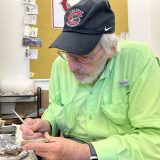
Toward an Autism Management Platform
February 27, 2014
By Ryan Burns, David Tyler, Erik Linstead
School of Computational Sciences
Students and faculty in Chapman University’s School of Computational Sciences are building an Autism Management Platform that will provide simple and intuitive communication among doctors, caregivers and parents of children diagnosed with Autism Spectrum Disorder.
One of the most common frustrations parents of children with Autism Spectrum Disorder (ASD) face is the inefficiency of communication with various physicians and practitioners. In a typical month, a parent meets with several different professionals, all of whom specialize in different areas of the disorder. Throughout these appointments, information is constantly repeated from doctor to doctor, only to float around in a 100 page-long Word document or spiral notebook. This is a highly unstructured approach to managing ASD, and is not sustainable given that 1 in 88 children are living with an ASD diagnosis. To this end, we have developed the Autism Management Platform (AMP) with the hopes of providing a solution for this very solvable problem.
AMP provides simple and intuitive communication between people involved in the development of any particular child diagnosed with ASD. These people may include parents, caregivers, siblings, physicians, or therapists. There are two distinct ways for users to interact with the AMP interface. End users such as parents or guardians of a child will use the AMP Android tablet application, while users like physicians may use a standard Web client distribution. Both subsystems do similar things in different ways.
An Exclusive Social Media Site
AMP starts with a particular user creating profiles for one or more children whose development they would like to manage. This is followed by the invitation process, which involves giving other AMP users (other parents, physicians) permission to access this child’s profile and feed. A common vision between AMP’s mobile application and web client is to present shared information in a feed-like view. Almost like an exclusive social media site, the application organizes and shows data chronologically in a way that is constantly updating and presenting new data. Once a user has access to a child’s profile, they can view and post to the child’s feed as they wish.
Encouraging Communication
Feed posts can represent any inquiry, event, or milestone in a child’s development that the user would like to share with those who have access to that child’s feed. They can consists of one or many of the following media features: textual descriptions, images, videos, audio recordings, tantrum timers, associated tags/milestones, recurring events, and standard Autism checklists. Once an item is posted to the feed, all other users with permission can view and comment on it. This provides a way for associated users to communicate with each other about specific events and milestones, rather than just general development.
Furthering Autism Research
Along with an interface for end users, AMP also implements an analytics framework, where all types of feed items posted can be aggregated and translated into meaningful data. For example, one might be able to see tantrum length spike around the time when the child’s weekly schedule was changing. With this framework in place, research possibilities are endless.
AMP provides a platform that encourages communication among everyone involved in the life of a child with ASD. By allowing people to share their child’s progress and allowing others to share their ideas about that progress, we can gain useful data for the continuous advancement of ASD research and treatment.
Computational techniques are being actively used in ASD research, but efforts are largely focused on drug discovery and educational technology. By focusing on data management and mining we hope to have a more immediate impact on terms of easing the day-to-day lives of those focused on finding the best treatment available for ASD.
We are actively seeking participants willing to provide feedback on AMP’s user interfaces, and eager to collaborate with researchers outside of the computational sciences who are interested in making strides in these areas. Questions or comments are welcomed and can be directed to Dr. Erik Linstead (linstead@chapman.edu).
Further Reading: Helping “the team” manage — OC Register
Meet the Authors:
Ryan Burns is a 4th year Computer Science major/Mathematics minor, concurrently pursuing a Master of Science in Computational Sciences with an emphasis in Computational Biology and Biotechnology. He currently works as a Software Engineer at devIO Inc. and was a key player in the development of the foundation of the original AMP Android app. In his spare time, he enjoys bike rides, golfing and playing music.
David Tyler is concurrently completing a three-year B.S. program in Computer Science and a M.S. in Computational Sciences, both at Chapman University. Over the last eight years, he has been developing software across a variety of platforms, and currently works as a Software Engineer at devIO, Inc and volunteers as webmaster for his campus internet radio station, Chapman Radio. A key developer for AMP, David has been overseeing the central API and systems coordination, and also manages the behind-the-scenes servers that power the platform.
Dr. Erik Linstead
Assistant Professor
Mathematics and Computer Science, School of Computational Sciences
Website
Research Interests: My research, in one way or another, is centered on machine learning and information retrieval. Most of my work has involved adapting and applying these techniques to the software engineering domain and bio/chemicalinformatics. I collaborate closely with the Baldi lab at UCI. I enjoy collaborating with ambitious and enthusiastic undergraduates who are eager to perform original research. I’m a firm believer in allowing undergrads to co-author research papers with me, and have had several papers published with my advisees.




